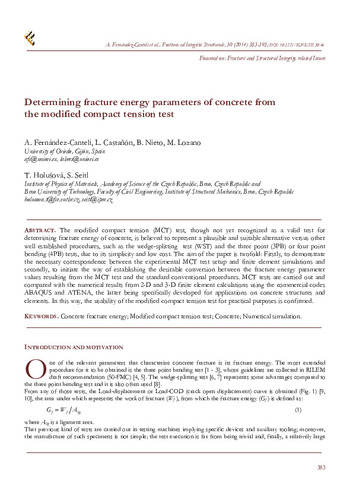Determining fracture energy parameters of concrete from the modified compact tension test
Subject:
Concrete fracture energy
Modified compact tension test
Publication date:
Editorial:
Gruppo Italiano Frattura
Publisher version:
Citación:
Descripción física:
Abstract:
The modified compact tension (MCT) test, though not yet recognized as a valid test for determining fracture energy of concrete, is believed to represent a plausible and suitable alternative versus other well established procedures, such as the wedge-splitting test (WST) and the three point (3PB) or four point bending (4PB) tests, due to its simplicity and low cost. The aim of the paper is twofold: Firstly, to demonstrate the necessary correspondence between the experimental MCT test setup and finite element simulations and secondly, to initiate the way of establishing the desirable conversion between the fracture energy parameter values resulting from the MCT test and the standard conventional procedures. MCT tests are carried out and compared with the numerical results from 2-D and 3-D finite element calculations using the commercial codes ABAQUS and ATENA, the latter being specifically developed for applications on concrete structures and elements. In this way, the usability of the modified compact tension test for practical purposes is confirmed
The modified compact tension (MCT) test, though not yet recognized as a valid test for determining fracture energy of concrete, is believed to represent a plausible and suitable alternative versus other well established procedures, such as the wedge-splitting test (WST) and the three point (3PB) or four point bending (4PB) tests, due to its simplicity and low cost. The aim of the paper is twofold: Firstly, to demonstrate the necessary correspondence between the experimental MCT test setup and finite element simulations and secondly, to initiate the way of establishing the desirable conversion between the fracture energy parameter values resulting from the MCT test and the standard conventional procedures. MCT tests are carried out and compared with the numerical results from 2-D and 3-D finite element calculations using the commercial codes ABAQUS and ATENA, the latter being specifically developed for applications on concrete structures and elements. In this way, the usability of the modified compact tension test for practical purposes is confirmed
ISSN:
Patrocinado por:
The investigation reported in this paper was supported by grants M100411204, CZ. 107/2.3.00/20.0214 and FASTS-14-2532 and projects BIA2010-19920 of the Spanish Ministry of Science and Innovation MICINN and SV-PA-11-012 of the Dept. of Education and Sciences of the Asturias Regional Government.
Collections
- Artículos [37541]
- Construcción e Ingeniería de Fabricación [508]
Files in this item





